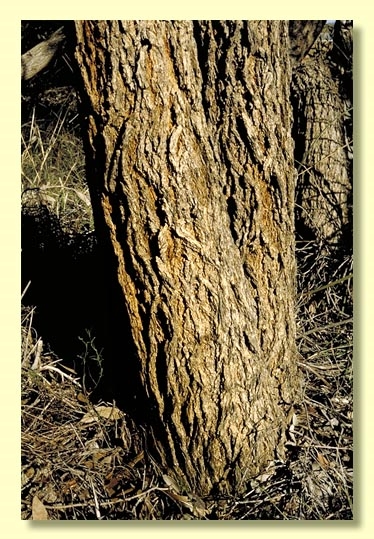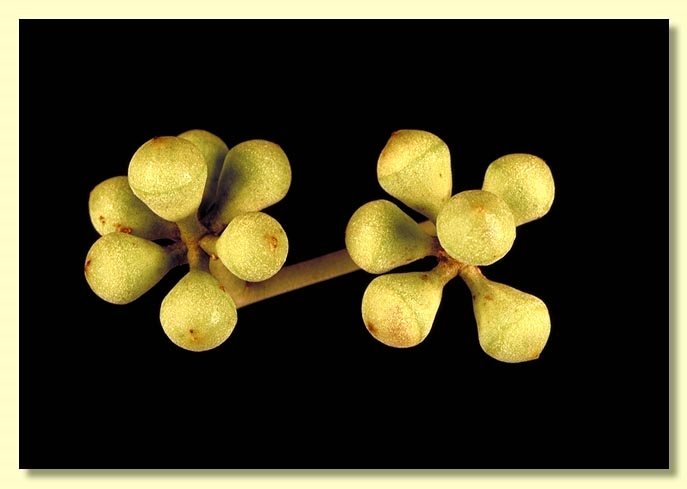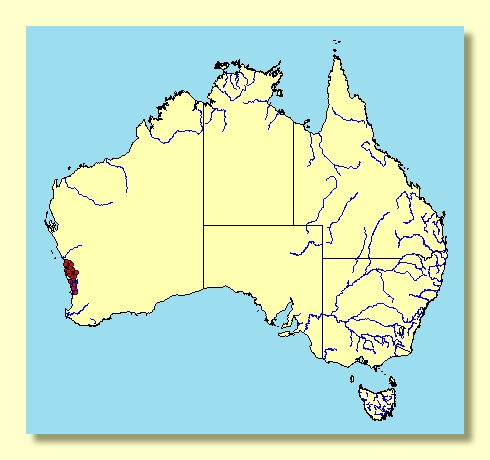Euclid - Online edition
Eucalyptus todtiana
Eucalyptus | Eucalyptus | Longistylus | Frutices | Diversiformae | Neuropterae
T: near Greenough R., W.A., 1877, F.Mueller s.n.; syn: MEL; near Arrowsmith R., W.A., 1877, F.Mueller s.n.; syn: K, MEL, NSW; near Moore R., W.A., 1 Feb. 1880, J.Forrest s.n.; syn: K, MEL, NSW.
Bark rough, to smallest branches, fibrous, soft yellow-brown, prickly, or the lower trunk only rough and scaly with upper trunk and branches smooth grey to yellow and pinkish brown.
Branchlets lacking oil glands in the pith.
Juvenile growth (coppice or field seedlings to 50 cm): stems rounded in cross-section; juvenile leaves opposite, sessile, elliptical to oblong with tapering base, 5.5–13 cm long, 1–1.6 cm wide, dull, grey-green, lowest leaves may have distantly denticulate margin but not so upper leaves.
Adult leaves alternate, petioles 0.4–2.2 cm long; blade lanceolate, 8–12.5 cm long, 1.5–2.2 cm wide, base tapering to petiole, margin entire, apex pointed, concolorous, dull to slightly glossy, light green, side-veins acute, reticulation moderate, intramarginal vein remote from margin, oil glands obscure.
Inflorescence axillary unbranched, peduncles 1.2–3.5 cm long, buds 7, 9 or 11 per umbel, pedicels 0.1–0.3(0.5) cm long. Mature buds obovoid, 0.8–1.1 cm long, 0.6–0.7 cm wide, scar absent, the single operculum conical to rounded and apiculate, stamens inflexed, anthers ± cuboid, versatile, dorsifixed, dehiscing by longitudinal slits that are not confluent apically, style long and straight, stigma tapered, locules 3(4), the placentae each with 2 vertical rows of ovules. Flowers white.
Fruit sessile or on pedicels to 0.1 cm long, cupular to truncate-globose or rarely hemispherical, 1.1–2.1 cm long, 1.4–2.5 cm wide, disc level only slightly descending, valves, 3(4), usually near rim level.
Seeds mid-brown, 5–9 mm long, obliquely pyramidal, dorsal surface curved to meet terminal hilum, margin prominently and often unequally winged, ventrally ridged.
Cultivated seedlings (measured at ca node 10): cotyledons reniform to orbicular; stems rounded in cross-section, slightly scabrid on lower internodes but smooth after ca node 3; leaves sessile, opposite (but never amplexicaul) for at least 9 or 10 nodes, then alternate and subsessile to shortly petiolate, narrowly elliptical to lanceolate, 8–10 cm long, 1.3–3 cm wide, margin distantly denticulate (and crinkled) to entire on upper leaves, dull green.
Flowering has been recorded in February.
A straggly small tree or mallee endemic to Western Australia, common from the Perth metropolitan area northwards on the sandplain to east of Geraldton. The bark is rough, yellowish brown and the adult leaves dull to slightly glossy, light green.
Eucalyptus todtiana belongs in Eucalyptus subgenus Eucalyptus series Diversiformae subseries Neuropterae, a group of mallee species characterised by adult leaves held more or less erect, buds with a single operculum (hence no operculum scar), cuboid-oblong anthers that shed pollen by two separate slits, ovules arranged in two rows on the placenta, pyramidal seed and seedling and juvenile leaves opposite for some to many pairs.
E. todtiana is most closely related to E. lateritica, a species of restricted distribution in the north end of the range of E. todtiana. E. lateritica differs by the less extensive rough bark, more open reticulation of the adult leaves, winter flowering, and smaller fruit. Both species are emergent mallees in heathland, but differ in substrate—E. todtiana occurs on sandplains whilst E. lateritica occurs on rocky lateritic slopes and tops of mesas.














